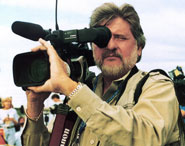 |
→ May 2006 Contents → Welcome
|
Welcome to the May issue of The Digital Journalist, the online magazine for visual journalism.
Los Angeles Times photographer Rick Loomis, who has been featured on The Digital Journalist with his dispatches from Iraq and who won the NPPA "Newspaper Photographer of the Year" in 2003, started to wonder what happened to soldiers who had been wounded in Iraq, from the moment of injury through the recovery process. Late last year, he and reporter David Zucchino were given a green light by the Times to document the story. For several intense weeks, starting in a forward medical unit in Balad, Iraq, they followed the process of trauma and triage, to recovery in hospitals in the United States. The result: a gritty, in-depth three-part series entitled "The Lifeline." It is a remarkable story. In addition to our photo galleries, and Loomis' own sidebar describing his experiences, you will find links to the Los Angeles Times' "Lifeline" slide show, which incorporates audio interviews with the wounded and those taking care of them.
If I were a graduate student at a photojournalism school, spending what little money I had to advance into documentary photography, I would want to make sure that the person teaching me was a relevant, "been there, done that" photographer. The students at The Graduate School of Photojournalism, University of California, Berkeley, are very lucky. Their professor, Ken Light, is a working documentary photographer. When he is not teaching, he is off doing major documentary projects, often with his wife, Melanie. They have produced five books in these off-teaching days: Texas Death Row; Delta Time; To The Promised Land; With These Hands, and most recently, Coal Hollow, a book about coal miner families in West Virginia. Ken uses his 6x6 camera to capture his subjects, and then Melanie moves in with her tape recorder to provide the narrative structure. It is a textbook example of how documentary is done today, without the help of a LIFE or TIME but simply old-fashioned journalistic commitment. J.B. Colson, the former head of the University of Texas photojournalism school, does the introduction, and we welcome him to our staff this month as a contributing editor.
Our Executive Editor, Peter Howe, is in a bad mood. As a former photojournalist and picture editor of LIFE magazine, he has glumly watched as the business of editorial photography in these troubling times has descended down a slippery slope. In his commentary "Don't Read This. (It's Too Depressing)," he shares his thoughts with us, and a reminder that "Journalism, when practiced honestly and ethically, is a source of light that is still our best defense against any Dark Ages that may be just around the corner."
We visited the National Association of Broadcasters (NAB) Convention in Las Vegas last month, and offer a special report on the industry's latest buzzwords, what people were talking about, and some of the new goodies introduced.
This month in Dispatches, we offer four diverse reports. Covering an unending war in the Congo, Spencer Platt writes of what he doesn't see: the press. In Israel there has been an outbreak of the bird flu and Rafael Ben-Ari reports on his experience covering the country's first incident. Veronique de Viguerie presents her trip to a village in Pakistan that is supported entirely through the sales of guns and ammunition from its small-family factories. And from Nepal, Brian Sokol reports from the bloody barricades in Kathmandu as pro-democracy protests turn deadly.
Jim Colburn reviews the new Canon 5D in our Camera Corner. He also writes in his column about the difference – and discrimination – between "newspaper" and "magazine" photographers.
Ron Steinman critiques the new journalism in "The Gang That Wouldn't Write Straight."
In Nuts & Bolts, Bill Pierce writes about getting your work published, as several photographers have done recently, including Arthur Grace. His new book, StateFair, will be featured in an upcoming Digital Journalist.
This month, we celebrate the first anniversary of Chuck Westfall's ever-helpful Q&A column, Tech Tips.
Karen Slattery and Erik Ugland discuss the pitfalls of composite photographs in their Ethics column.
This month, E-Bits Editor Beverly Spicer turns her attention to the media, comedy, and the best way to deliver the news these days in the ongoing battle between Truth and Truthiness. Inspired by Shakespeare and an ancient Chinese curse, she muses about the drama unfolding in these interesting times.
"Stan" is the title of this month's only journal on Assignment Sheet. Retired Newsday (Long Island, N.Y.) staff photographer Dick Kraus writes a tribute about a colorful character with whom he worked for many years. Kraus says that it's just another chapter out of his Damon Runyonsque songbook.
We hope you enjoy this issue. Please pass on the word to all your friends, colleagues, and editors. Dirck Halstead
| ||||||
